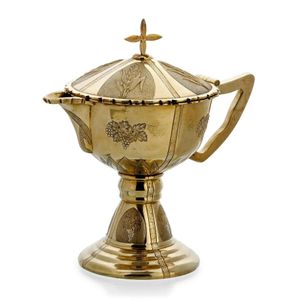Australian Silver Gilt Ecclesiastical Ewer by James Steeth & Son
An Australian silver gilt ecclesiastical ewer, by James Steeth & Son, Melbourne, early 20th century on a stepped circular foot, the body with spout and handle, embossed and chased with bunches of grapes, domed cover with sheaves of wheat and stylised cross, marked 'Southern Cross/JS&S/STG SIL/STEETH', 27 cm high, 1470 gms (47.4oz). Provenance: The Collection of the late Graham & Elizabeth Cocks
You must be a subscriber, and be logged in to view price and dealer details.
Subscribe Now to view actual auction price for this item
When you subscribe, you have the option of setting the currency in which to display prices to $Au, $US, $NZ or Stg.
This item has been sold, and the description, image and price are for reference purposes only.
- Embossed / Repousse - Embossing, also known as repousse, is the technique of decorating metal with raised designs, by pressing or beating out the design from the reverse side of the object.It is the opposite of chasing, where the decoration is applied from the front. An embossed or repoussed object may have chasing applied to finish off the design.
- Ewer / Pitcher - A type of jug with a narrow neck bulbous body and wide spout, originally used for carrying and storing liquids such as water or wine. In medieval times they were the source of water to wash ones hands during and after a meal. later the shape was used for vessels in silver, gold, glass and ceramics.
In Victorian times they were made in ceramics and occasionally glass with a matching basin, and sometimes other accessories such as a soap holder or toothbrush holder. Their purpose was to provide facilities for personal washing In the early 19th century were often enclosed in purpose built stands, and later resided on a washstand..
Sometimes the words "ewer" and "pitcher" are used interchangably, but a pitcher is generally considered to be a jug, and would have a wide mouth, and a gently tapering body.
This item has been included into following indexes:
Visually similar items

Dresden German floral porcelain lidded urn, c1950s. 40 cm
Sold by
in
for
You can display prices in $Au, $US, $NZ or Stg.

Wedgwood Jasper Ware lidded urn having two hooped handles, decorated raised foliate appliques & classical figures. Height 30 cm
Sold by
in
for
You can display prices in $Au, $US, $NZ or Stg.

Wedgwood green Jasper Ware lidded urn having two hooped handles, decorated raised foliate appliques & classical figures, height 29.5 cm
Sold by
in
for
You can display prices in $Au, $US, $NZ or Stg.

A Regency copper samovar, urn form body, similar to above.
Sold by
in
for
You can display prices in $Au, $US, $NZ or Stg.
